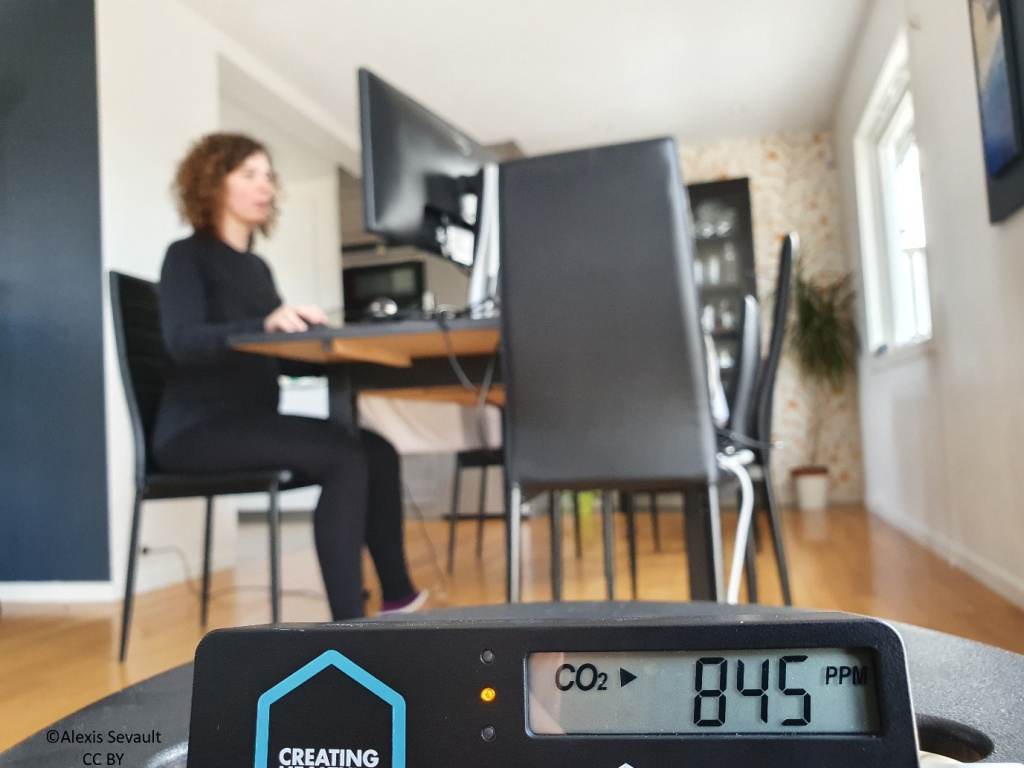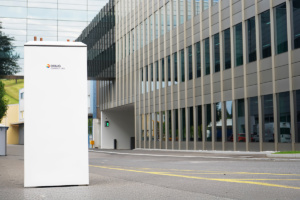With the high cost per square meter, most of us end up sharing “office” in a living room since not everyone can afford to have a separate office room. So, I decided to write this blog giving five easy tips on indoor air quality to “survive” this confinement and make it as productive as possible.
Read more about Maria’s PhD work on Indoor Air Quality at ZEN: The Research Centre on Zero Emission Neighbourhoods (ZEN) in Smart Cities
For those of you lucky enough to have mechanical ventilation, there is only one piece of advice: let the mechanical ventilation run, and probably if you are ALL at home, just set it to “forced mode”. But for those of you sitting in a home office with natural ventilation, a good indoor air that promotes your efficient work requires a little bit more from you.
1. Keep CO2 levels below 1000 ppm
Human beings, animals and plants have the habit of breathing. We breathe in oxygen and flush out carbon dioxide (CO2). This CO2 is originated in our life processes, for instance, when we burn fat for maintaining our body temperature. Thus, the exhaust gases contain CO2, heat and moisture like most other combustion processes.
On average, we produce CO2 at a constant rate proportional to our activity. For instance, when adults work reading or typing in an office, we produce about 16 to 25 litres of CO2 per hour[1]. Children produce a little bit less. CO2 accumulates in the air, and if we have no ventilation, it gets more concentrated. As an example, we are two people sitting in a 30 m2 living room in a house from the sixties (with small window ventilation openings). It takes us about 1.5 hours to increase the CO2 concentration from 400 to 1100 ppm.

CO2 is commonly used as a marker for other pollutants, and many studies relate CO2 over 1000 ppm to 1) Respiratory symptoms, asthma, and allergy symptoms, 2) Airborne infectious diseases and sick leave, 3) Acute health symptoms (Sick Building Syndrome (SBS) and Building Related (BR) symptoms). Additionally, a study from Satish et al.[2] concludes on a significant decrease in the work performance with CO2 concentrations over 1000 ppm and marginal or even dysfunctional levels of performance or decision-making at CO2 over 2500 ppm to which we arrive in 4.5 hours.
Thus, do something! Open the windows! If there is a significant temperature difference between your “office” and outdoors, typically five minutes opening is enough. If the temperature difference is smaller, then you need more prolonged periods of opening. If the wind blows against your window, just two or three minutes may be enough. If you are more people, open more often, but at least 5 to 10 minutes every hour! So, open the window every hour; small periods usually are enough, just do it! This will also help you feel more rested and sleep better.
2. Relative humidity and temperature
In this season of influenza and COVID-19, maintaining the relative humidity (RH) close to 40 % is important as this affects virus survival. The influenza virus may survive better in colder drier environments. At low relative humidity, it retains its maximum infectivity[3]. The World Health Organization officials now claim: “The coronavirus can go airborne, staying suspended in the air depending on factors such as heat and humidity.”
This means that the virus can float through the air and infect you even without direct contact or droplets from sneezing or coughing. However, too high RH (over 60 %) is neither good as it may cause discomfort connected to inhibiting sweat evaporation. Also, at high relative humidity, we perceive the air stuffier and increasingly poorer, probably as there is an increase of emission of VOC (volatile organic compounds), growth of microorganisms (fungi, bacteria, viruses, etc.) and occurrence of allergens are also linked to high RH.
As written above, we, human beings, produce humidity, and many of our activities produce humidity as showering, drying wet clothes, cooking, having plants, and pets… Thus, we need to ventilate to remove the excess of moisture. In our living room, we maintain an RH about 40 % by opening the windows regularly, as explained before and by maintaining temperature from 20 to 22 °C. If we increase the temperature, we reduce the RH. Also, the performance of an office worker looks like a curve with a maximum between 20 and 23 °C.
3. Pollen and traffic particles
The pollen season has started in Europe. It will not be a surprise to tell people allergic to hazel and birch in Trondheim that the pollen season has started. Opening windows gives an easy access to pollen and traffic particles in your house. The amount of pollen and particles that enter depends on the outdoor concentration and the size.
Still, we recommend opening the windows, not entirely but tilted[4]! However, if you are allergic, you should always open in the leeward side of your house and, if possible, when there is less wind so that the wind will not make the pollen float.The same applies for traffic, open the windows further from traffic. If you are very allergic to pollen, mold spores and dust, you may have to keep your windows closed and run your filtered mechanical ventilation that you probably/hopefully have already installed.
4. Focus on the kitchen
The kitchen is the room where we have the biggest source for pollutants in the house. We cook which produces moisture; we keep the trash there, producing VOC, bioaerosol, bacteria, formaldehyde, we toast bread, or run the oven producing particulate matter… Thus, it is essential that to close the kitchen door if you can and run the extraction fan. If you don’t have a door, because you have one open solution kitchen-living room, remember to run the extraction fan when you are cooking, even if it is noisy, to avoid the spreading of pollutants to the rest of the house.
5. Maintain cleaning and empty the trash
As written above, the trash is a huge source of pollutants. Dust may accumulate clogged together with hair and with the electrostatic forces getting even bigger. One of the most eminent researchers in ventilation, Max von Pettenkofer in 1858, said: “If there is a pile of manure in a space, do not try to remove the odor by ventilation. Remove the pile of manure.”
We need to excel in cleaning. Vacuum clean much more often than you usually do! Clean the working surfaces and also empty the trash more often if you can be exposed to pollutants emitted from it. Beyond handwashing to fight the spread of COVID-19 ( DO NOT STOP WASHING YOUR HANDS), it is also about cleaning more often. The virus can spread by direct contact with a surface or object that has the virus.
[blue_box]Read more about Maria’s PhD work on Indoor Air Quality at ZEN: The Research Centre on Zero Emission Neighbourhoods (ZEN) in Smart Cities[/blue_box]
[1] Persily A, de Jonge L. Carbon dioxide generation rates for building occupants. Indoor Air. 2017;27(5):868–879. doi:10.1111/ina.12383
[2] Satish, U., et al., Is CO2 an Indoor Pollutant? Direct Effects of Low-to-Moderate CO2 Concentrations on Human Decision-Making Performance. Environmental Health Perspectives, 2012. 120(12): p. 1671-1677
[3] Noti JD, Blachere FM, McMillen CM, et al. High humidity leads to loss of infectious influenza virus from simulated coughs. PLoS One. 2013;8(2):e57485. doi:10.1371/journal.pone.0057485
[4] A. Menzel, M. Matiu, R. Michaelis, S. Jochner Indoor birch pollen concentrations differ with ventilation scheme, room location, and meteorological factors. Indoor Air 2016










Comments
Great advice! For a healthy home office, ensure clean air ducts and filters, proper ventilation, controlled humidity, regular dusting, and use of air purifiers. These simple steps keep your workspace comfortable, productive, and free from indoor pollutants.
One suggestion: adding guidance on using HEPA purifiers or CO₂/Humidity sensors would help readers take even more proactive steps. Thanks again for these insightful and actionable tips!
Great tips for maintaining good indoor air quality in a home office! Clear and practical advice that will definitely help improve productivity and health. Love it!
Great tips for maintaining good indoor air quality in a home office! It’s amazing how simple changes like proper ventilation and adding plants can make such a big difference in health and productivity. The focus on air quality is often overlooked but so essential for creating a comfortable and efficient workspace.
Great info! Thanks for sharing such information with us.
Hi there! Thanks for sharing. Many helpful tips have been offered here, but I want to add that cleaning air ducts at least every 12 months is also highly recommended. Otherwise, dust, allergens, and harmful particles will accumulate there and cause bad indoor air.
Thank you for sharing such helpful content! And as for cleaning, don’t forget about air conditioner filters. Dirty filters are often the cause of poor indoor air quality. You should aim to check your filter every month, especially during the peak winter and summer months, when it’s likely that your system will be running at almost maximum capacity for long periods.
Very impressive, thanks a lot for sharing a helpful post with us.
Hello, Maria! The tips are of great help to those who try to look after their health. However, some important points are missing: to improve indoor air quality and to stay safe one should also check for radon and stay away from synthetic fragrances. You can learn more about it in our article on the subject, hope your readers will find it useful: https://happyhiller.com/blog/improve-air-quality-in-your-home/
Nice tips. Thank you for shear with us.
These are some wonderful tips Maria! Another way to for improving air quality would be to reduce exposure to carbon monoxide. This gas is generally released from central heating systems, gas heaters, and kerosene stoves.